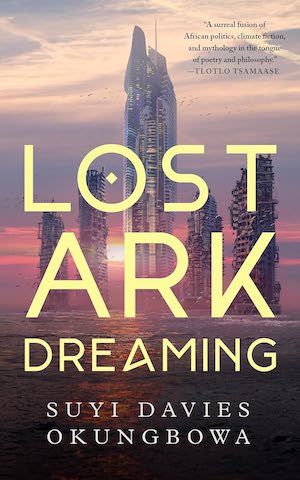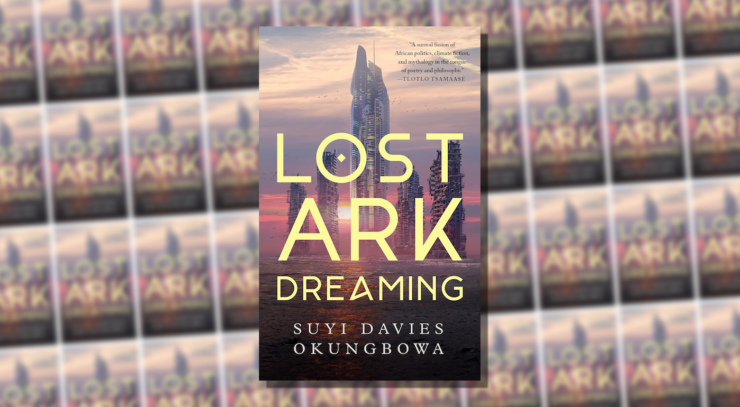Lost Ark Dreaming is set in the near future, after the seas have risen dangerously, West Africa has been swallowed by the Atlantic, and climate change has flooded Nigeria. All that remains are the Fingers, and those who live within these five high rises that stand in the sea, tower block buildings that are divided by levels, by class, by strict socio-economic hierarchy. Many levels exist submerged under the sea, populated by those who have less, who live without windows, without daylight, but continue to work to keep the towers functioning, until the towers, too, fall—all but one. That the towers always were a highly capitalist system is made clear early on, and what remains of society is still very much the same. There is a stark divide between those who have, and those who have not, and Nigerian writer Suyi Davies Okungbowa makes it clear that “This, friend, is the way the world always ends, has always ended since we have watched it together: with those who Have choosing demise—always demise—for everything but themselves.”
The story takes place in the only remaining tower, The Pinnacle, “a metal container, and its inhabitants… cockroaches captured and bottled up inside it. No matter how good any of them had it, it was only a matter of time before they would come erratic, strained, stretched taut to the limits of their sanity.” But things seem to be functioning well enough in the Pinnacle when we meet a “Midder” analyst Yekini, who is tasked with accompanying “Upper” bureaucrat Ngoni to the lower, submerged levels where the tower appears to have sustained some damage. Once they meet the level nine “Lower” foreman Tuoyo, it soon becomes clear that there has been a breach in the tower, potentially by a Child—a creature from the deep, a being almost mythical but feared by all. Things quickly accelerate until the three main characters from different levels are forced to work together not just to survive but also to change the status quo of their society. Or at least attempt to.
Buy the Book


Lost Ark Dreaming
“The Children” are those who were left for dead when the seas rose, and have adapted to survive, an ancient power giving them life and memory. In the new world’s lore they are Yemoja’s children, Yemoja being the Yoruba goddess of creation, of water, of motherhood. The Pinnacle Leadership has made sure that the inhabitants of the tower fear any contact with these outsiders, providing special briefings for analysts in the Pinnacle’s temple, where “an elderly master cleric sat them down and told them the history of the devil spawn that was Yemoja’s Children and what they were capable of.” Some people think of them as “monster ghosts who could slip though walls. Some thought of them as magma-spitting demons, complete with tentacles and horns. Some thought of them as shape-shifting ancient warriors with shark-like teeth… The only thing everyone agreed upon was that they looked obviously humanlike and could pass for one.” But are the Children actually any of these things, or are they something more? Yekini and the others have to question everything they have been taught, and explore their deeply personal reasons for wanting to make their mark in a way that may require them to go against the Pinnacle’s Leadership.
The narrative shifts between the perspective of the three main characters, as well as brief interludes that fill us in on the past via poetic memories or recorded history from archives. While these help round out the worldbuilding (which can otherwise feel limited at times, mainly restricted by the novella’s length), they sometimes feel like a lot of exposition. We still don’t see a lot of what happens in the tower, its society, on a day to say level; we are told, but we are not shown. Most worldbuilding concerns and questions are addressed, albeit briefly, but because this is a novella, some sacrifices must be made. Yoruba culture and spirituality shine through of course, and therein lies the novella’s strength: It is its own unique take on climate change fiction, from a non-eurocentric perspective we are only just starting to see more of.
There are a lot of valid, pertinent points being made in Lost Ark Dreaming, which packs quite a punch for its length, with some weighty subjects and high concept ideas. It condemns imperialism, capitalist power structures, and colonial powers exploiting poorer countries’ resources while hiding their own massive contribution to the climate change crisis; it touches on themes of displacement, generational trauma and memory, all the while keeping up the pace of a thriller, of a sensitive, nuanced rage against the machine rebellion.
Sometimes novellas bite off more than they can chew, but Lost Ark Dreaming handles many big ideas well, though it does lean rather heavily on similar narratives, some quite recent, like Rivers Solomon’s The Deep and Snowpiercer. It also feels like a contemporary take on J.G. Ballard’s High Rise for a post climate-apocalypse world, if High Rise was set in an organised, totalitarian tower block rising from the sea. All three of these stories are given credit in the acknowledgements, too.
Okungbowa doesn’t shy away from didacticism to get his point across at times, either. Sometimes via the interludes, sometimes straight from the characters mouths, we are reminded of how the only way to survive our impending climate apocalypse is to be less selfish; we are told of “stories of civilisations just like yours and mine, fallen because they could not each recognise a world—worlds, even—beyond themselves. Peoples so limited in thinking that they were happy to be subjected to the slim imagination of a few, if only it offered them safety in a world too big for them to comprehend.” It is our stories, our shared human history that will bring us together, if we take the risk to tell them.
“We are but messengers,” the Child says to Tuoyo, “every once in a while, we perish at the mercy of the weighty stories we carry. But sometimes—sometimes, we prevail, and the stories we carry change the world.” It is these stories that Lost Ark Dreaming is attempting to carry—ambitiously, astutely.
Lost Arc Dreaming is available now from Tordotcom Publishing.
Read an excerpt.










